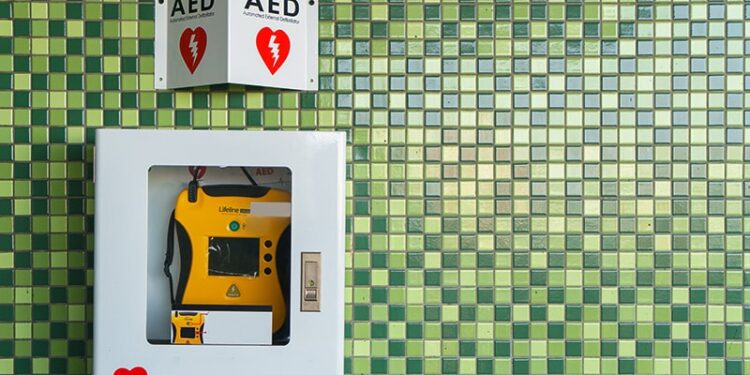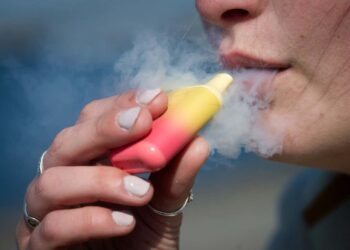An apparently healthy young woman going through a typical day of university classes in Italy collapses suddenly. For many people, this medical emergency would end in tragedy. But in this case, the woman’s friends retrieve an automated external defibrillator (AED) and give her the shock she needs to restore her normal heartbeat. She recovers fully, and her future looks bright.
This true story is the best-case scenario for patients who experience sudden cardiac arrest, but such stories remain frustratingly rare, experts said. Between 6% and 22% of people who experience a cardiac arrest outside of a hospital survive the event, according to a 2019 study of 12 countries; the rate varies widely both between and within nations. Sudden cardiac arrest continues to account for about half of all cardiac deaths and a significant percentage of all deaths, despite advances in the identification and treatment of the underlying cardiomyopathies, arrhythmias, and coronary artery disease that can lead to cardiac arrest.
About half of all arrests strike people who had no prior diagnosis of cardiac disease.
Screening people for cardiac diseases, treating these conditions, and, when all else fails, resuscitating victims promptly save lives. But much more vigilance, public awareness, and research are needed, experts said. “It’s a social issue and an economic issue,” said Eloi Marijon, MD, a cardiovascular and cardiac electrophysiology specialist at the European Georges Pompidou Hospital in Paris.
Marijon was a co-author of a 2023 report for a Lancet Commission that called for multidisciplinary action to reduce the global burden of sudden cardiac death.
Many Causes, One Outcome
“Sudden cardiac death is a mode of death, not a disease,” Marijon said. “But it’s a unique mode of death. You are dead, but it’s still reversible for a few minutes.”
A variety of cardiac diseases can form the “substrate” that leads to an arrest, said Kumar Narayanan, MD, a cardiologist and electrophysiologist at Medicover Hospitals in Hyderabad, India, and a co-author of the Lancet Commission report. A “trigger,” such as acute ischemia, electrolyte imbalance, or drug effects, is necessary. Finally, the autonomic nervous system that normally modulates cardiac rhythm must fail.
Because so many cardiac conditions can lead to arrest — conditions people may not even be aware they have — preventing and treating sudden cardiac arrest is challenging.
Sudden cardiac arrest has different profiles. In people younger than 35 years, the main culprits are structural and electrical cardiac abnormalities, whereas in older people, the main cause is coronary artery disease. Yet experts say they are starting to see more arrests due to coronary artery disease in younger people.
Media reports of athletes collapsing during a sport have brought attention to cardiac arrest in young people. Sudden cardiac death, while quite rare, was the most common medical cause of death among athletes aged 17-24 years who died during a wide variety of sports, according to a 2015 study of a National Collegiate Athletic Association (NCAA) database.
Many of the conditions that lead to arrest in athletes younger than 35 years are inherited, said Sanjay Sharma, MD, a cardiologist at City St George’s, University of London, England, and a co-author of a 2024 review of sudden cardiac deaths in young athletes.
In a registry of sudden death in athletes, in which hearts were examined by a cardiac pathologist, researchers observed “nothing wrong with the heart or coronary arteries” in many cases, Sharma reported. “They are sudden arrhythmic deaths. Why do these happen? If we look at first-degree relatives very comprehensively, we find an inherited electrical cause in 40% of these families.”
To prevent such deaths, some jurisdictions and sports associations have started to screen athletes for cardiac conditions before they participate in sports. “Whatever we do to identify these young people, on ethical or moral grounds, it has to be easy to do and pragmatic,” Sharma said.
In the US, screening consists of a physical examination and individual and family history. An ECG is recommended but not required, according to a joint scientific statement from the American Heart Association and the American College of Cardiology, because costs and rates of false-negative and false-positive results are high. In contrast, the European Society of Cardiology recommends 12-lead ECG screening.
Data support that approach. In Italy, where ECG screening is mandatory, the rate of sudden cardiac death decreased from 3.6 to 0.4 per 100,000 athlete-years, according to a 2006 study. The 2015 NCAA study, by comparison, found a rate of sudden cardiac death of 1.9 cases for each 100,000 athlete-years.
But no test can pick up all cases. And tests must be repeated, Sharma said. “A one-off screen is not enough,” but the best schedule for screening — whether every year or 2 years — is unclear, he added.
Furthermore, such screening can have false-positive results. For example, high-intensity exercise can cause benign changes to the heart, commonly called athlete’s heart, which may point to cardiomyopathies on ECG or imaging. In some athletes, mainly men who participate in endurance sports, the dimensions of ventricles can change, whereas in other athletes, mainly Black men who play team sports, the left ventricular wall may thicken. Additional imaging and testing are required to distinguish these unharmful changes from serious cardiac conditions, he explained.
For most older adults, coronary artery disease remains the main underlying cause of arrest, although estimates of rates differ. Arrests can result from heart failure or during the acute phase of a myocardial infarction. The aging of the populations in most countries means rates of sudden cardiac arrest are likely to rise.
Experts agree the general cornerstones of prevention are the same as for coronary artery disease: Better screening for cardiovascular risk factors, prompt investigation of possible ischemia or heart failure, and effective therapies when disease is detected.
When Arrest Occurs
When sudden cardiac arrest strikes, the first minutes determine survival. Estimates put the survival rate at less than 10% without intervention. If an arrest is witnessed, the likelihood of survival doubles, Sharma said. If cardiopulmonary resuscitation (CPR) is started immediately, survival triples, and if defibrillation is administered within the first few minutes, it increases fivefold.
Because of highly visible dramatic rescues and tragic but avoidable deaths, CPR and AEDs have taken center stage as tools to improve survival after a sudden cardiac arrest. However, the deployment of these methods is as much a public policy issue as a medical one.
Many jurisdictions have put AEDs in sports facilities because of the well-known risk for sudden cardiac arrest in athletes. This policy is supported by studies that show that CPR and AEDs improve survival rates following arrest during exercise — from 15% to 55% in Switzerland and up to 70% in Sweden — although rates of sudden cardiac arrests are staying the same or rising.
The recent RACER 2 study of marathons and half-marathons in the US showed that the rate of arrest from 2010 to 2023 was similar to that from 2000 to 2009, but the rate of sudden cardiac death was cut in half. Emergency preparedness at races improved after the 2012 RACER 1 study reported the number of sudden cardiac arrests and deaths occurring during marathons, said Jonathan Kim, MD, founding director of sports cardiology at Emory University in Atlanta.
By the time RACER 2 was conducted, all racers who collapsed during the marathons assessed received CPR from bystanders, and almost all received defibrillation, leading to a dramatic decline in mortality.
AEDs in public places, such as transportation stations and office buildings, are common in some jurisdictions but not in others. Monaco has defibrillators “everywhere — you couldn’t miss them,” Sharma said, whereas Kenya lacks basic equipment such as ECGs, not to mention AEDs.
Officials in the Italian city of Senigallia have been installing AEDs in residential areas to improve the survival of people who experience sudden cardiac arrests at home. “You should have an AED inside an apartment building, like a fire extinguisher,” said Simone Savastano, MD, a cardiologist at Fondazione IRCCS Policlinico San Matteo in Pavia, Italy, who helped write a 2020 literature review on the devices. “If you have one at the entrance, everyone knows that there is an AED. In case of an emergency, they can run downstairs and use it,” Savastano said.
However, placing AEDs is only a first step. Paris has numerous AEDs in public places, but 40% of them are out of service, Marijon said. “It’s good to put an AED on the wall, but you have to maintain it,” he said.
AEDs should be required by law, just like fire extinguishers, Marijon and Narayanan pointed out, and good Samaritan laws that exempt bystanders who use AEDs from liability are also needed. However, an American study showed laws requiring AEDs in sports facilities do not significantly increase the number of times bystanders use an AED to treat an arrest, said author Saket Girotra, MD, SM, a cardiologist with the University of Texas Southwestern Medical Center in Dallas.
“I was surprised because I would have expected some increase in AED use in states that required them to be placed in athletic facilities,” Girotra said.
Laws are not enough, he said. “I think that is a lesson for the community and for policymakers. We need to go beyond passing these laws. We need to make sure that the people who operate the facilities are well trained and the public is informed,” Girotra said.
Among the measures recommended is widespread CPR training. A successful public campaign in India involved celebrities talking about cardiac arrest and encouraging members of the public to register for CPR training, Narayanan said.
American and European guidelines say every emergency medical system must create a way to alert citizens and first responders to someone having an arrest, Savastano said.
Today’s AEDs are foolproof. They provide automated aural instructions to the user throughout the process and a picture of where to place the pads on the patient. Sensors determine whether the patient needs a shock. “It’s impossible to use it in the wrong way,” Savastano said.
For bystander intervention, smartphone apps are useful. “In many countries, apps alert citizens in case of a cardiac arrest near them,” he said. Apps showing the locations of nearby AEDs help citizens find one and get it to the patient. “In Switzerland, in one canton, they have been doing this for many years. They are able to reach every patient with a cardiac arrest within 3 minutes,” Savastano said.
Political willingness is needed to institute CPR and AED measures. “Politicians probably think that cardiac arrest is not a political concern,” he added. “But it is.”
Marijon disclosed receiving research funding, consulting fees, and an honorarium from a variety of medical device makers and drug companies.
Kim reported receiving grant funding from the Atlanta Track Club and the National Institutes of Health (NIH). RACER2 was supported by NIH/National Heart, Lung, and Blood Institute (NHLBI) grant R01HL162712.
Girotra reported receiving grants from the NHLBI and personal fees from the American Heart Association for editorial work outside the article discussed in this story.
Carolyn Brown is a freelance scientific and biomedical reporter in Ottawa, Ontario, Canada.
Source link : https://www.medscape.com/viewarticle/sudden-cardiac-arrest-victims-often-have-no-prior-diagnosis-2025a1000grs?src=rss
Author :
Publish date : 2025-06-24 09:40:00
Copyright for syndicated content belongs to the linked Source.














